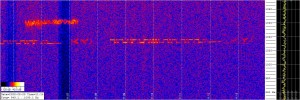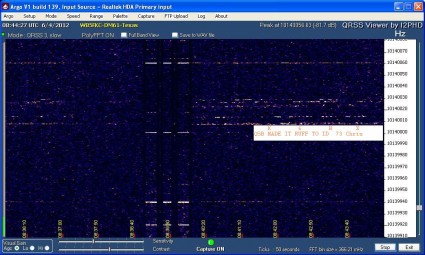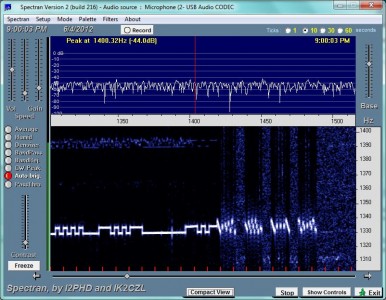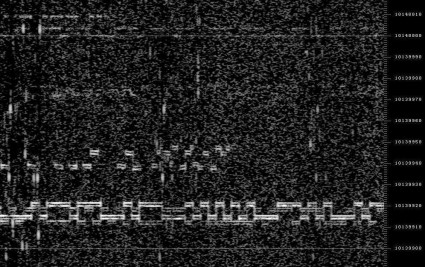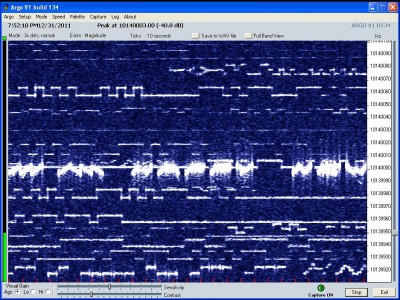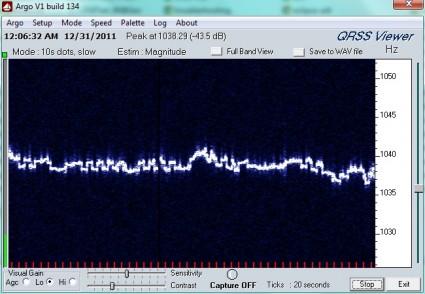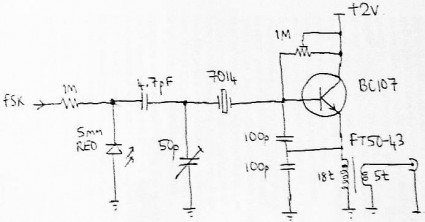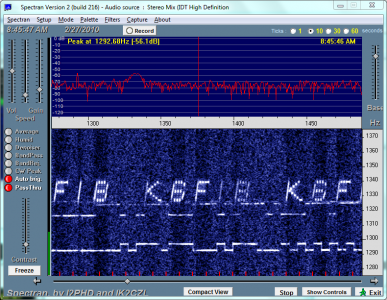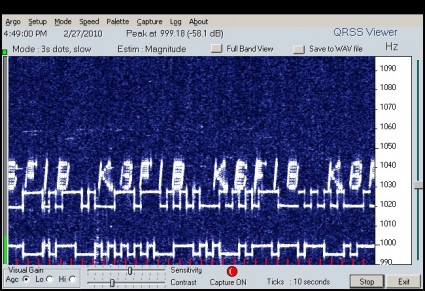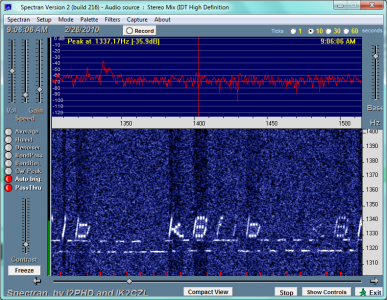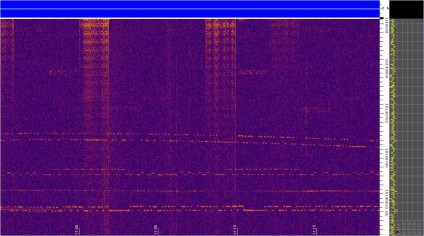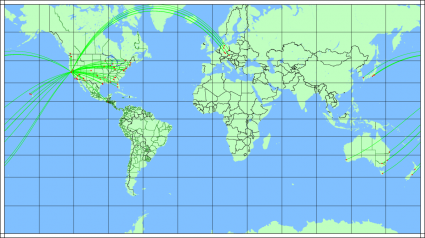I hooked up my new DS3231 clock module to an Arduino that was being fed with the one pulse per second input from a locked GPS, and counted the number of pulses from each. In 3170 seconds, the clock module generated 103874565 pulses, for an average pulse per second of 32768.0015773 pulses per second. That’s really good, only about 2 seconds per year. Of course this was a short term test, under relatively stable temperature conditions, but still, I’m highly impressed. I’m thinking that using this to drive my WSPR radio beacon is likely to work out very well.
Category Archives: QRSS
First reception report for the K6HX OpenBeacon…
The honor goes to Chris, WB5FKC. Chris and I exchanged signal reports occasionally back when I last was on the QRSS kick a couple of years ago, so it was nice and fitting that he was the first to spot me again. The signal is pretty rocky, but the power level here is just 100mw, which is just 1/50th the power of the previous 5W that I commonly used for QRSS back then.
I don’t know if I could have spotted this, but here is the screen grab that Chris sent me:
I thought I would be transmitting about 35hz lower than is shown here. I’ll have to look into that more.
Thanks Chris, and good to be heard by you again, OM! 🙂
My OpenBeacon is on the air…
Sometime last week, I got my Etherkit OpenBeacon kit in the mail. Like many of my projects, it was probably destined to sit on the shelf for some time, but in a fit of personal productivity (for a loose definition of productivity) this week I cleared a few hours of my time and got it assembled, and now is on the air with the cloud warming power of 100mw. I positioned it’s signal in the middle of a bunch of QRSS signals as received by my IC-735, so it should be within the QRSS sub-band on 30m, but my IC-735 itself is rather poorly calibrated (off by 150 Hz or so) so I’m not as yet certain of it’s exact frequency. But it should be in the ballpark. I’d love to here from anyone who hears it and can provide a signal report. It’s currently sending DFCW3.
But I got ahead of myself. About the kit: it is a very nice PC board, well laid out and not too cramped. All components are traditional through-hole. It requires that you wind three toroidal coils: two ordinary ones with sixteen turns, and one bifilar transformer of ten turns. If you haven’t wound coils before (and I’ve only wound a few) you probably will find that the most daunting part of the construction.
The instructions are.. well… I’d characterize them as barely adequate. They consist mostly of a BOM and a few rough pointers. If you look carefully, you can install things incrementally, but it’s kind of a pain to do things that way. I began by simply installing all the caps and resistors, and then enough to test the microcontroller was functional. The board uses an ATtiny85 by Atmel, and runs software which allows it to appear as a USB device. That all worked fine the first time I booted it up, no great surprises. When I finished fleshing out the oscillator, I was slightly confused because it didn’t appear to start, and I noticed that the red LED indicator wasn’t on. A bit more careful examination of the schematic showed that unless the 2N7000 was installed that would probably be the case, so I ignored it and simply fleshed out the rest of the rig. In the end, it all turned out fine. I think they could be a bit clearer on how to mount the power transistor: the double line indicates the backside (non-label side) of the transistor. That would be easy to screw up if you weren’t careful.
When I powered it on, I could hear it’s signal about 4Khz low on my IC-735, even without any antenna hooked up. You have three adjustments: one cap controls the frequency, one controls the bandwidth of the modulated signal, and a trim pot controls the output power. By the time I finished this, I was a bit tired, and didn’t have much desire to do detailed testing. I hooked up my SDR-IQ to accurately measure the output frequency, and tweaked it to be right around 10.140000 Mhz. The tuning is fairly twitchy, even small turns of the tuning cap can send the oscillator two or three hundred hertz from where you start. But with the SDR-IQ, you can watch fairly easily, and I soon had it on frequency.
I didn’t have a dummy load or anything yesterday, but I put it on the air. I didn’t see any sign of it on W4HBK’s Florida grabber (most closer ones appear to be off the air for now), but I think it was all working.
Today, I wanted to make a more accurate estimate of the output power. I constructed a small dummy load out of 4 180 ohm resistors wired in parallel (yes, that’s just 45 ohms, so sue me). I then clipped my handy Rigol scope on either side of the resistors, and measured the RMS voltage. Setting it to 4.5V into a 45 ohm load should make for 100mw. I also checked the limits: right around 300mw, just as described in the documentation.
Here are a couple of screen grabs that I made using Spectran while testing the beacon. The first shows it’s default DFCW3 signal, the second, the somewhat less effective but still cooler looking Hellschrieber.
I also recorded part of me assembling it in time lapse mode on my iPhone. Not informative, but fun to watch. Sadly, my batteries died before finishing it, next time I’ll use an A/C adapter on the phone. The utility I used OSnap! is nice, but very slow in constructing the video and uploading the results to YouTube.
I’ll try to follow up with more information about this project in the near future.
Seeing double on QRSS grabber…
Here is a snapshot from my QRSS grabber earlier today. You might want to click it to see it full size:
I’m curious: what phenomenon is causing the strong line doubling of the signals near the bottom? Note: not all the signals demonstrate this phenomenon, and it’s relatively rare, and commonly just fades away. Also note that the signal at the top does not show this line doubling. I suspect all the signals which are line doubled are in New Mexico.
Bonus question: I keep seeing a small wiggle like the one around 10.139975 or so, starting on 10 minute boundaries and lasting for about one minute. Anybody have any idea who that is?
WA0UWH’s Propeller Beacon received at K6HX…
I could of days ago, I blogged about WA0UWH’s Propeller Beacon. Over the last couple of days, I worked on fixing a few small issues with my old beacon code, and have an experimental QRSS grabber up and running on qrss.info. And, what’s totally cool is that I’m hearing Eldon’s QRSS beacon, just over 700 miles away. Check the screen grab:
Eldon’s signal is the slant-Morse signal just about 1/3 of the way down (right around 10.140050). His signal starts with a propeller, and then has a series of slanted lines. Forward slashes are read as dots, and backward slashes as dashes. You can work out WA0UWH (easier on the signal near the right edge), followed by the letters WA. Pretty neat!
Other callsigns are AE5XI, NM7J, KD5SSJ, KC5EVR (I think) and WV5N, read from top to bottom. Early in the morning (around 4:00AM my time) I also received W0TJ and the flying W of Bruce, W1BW, but as yet I haven’t heard anything from our VK or ZL brethren down under. I’ll keep the grabber up for the rest of the week, perhaps down only intermittently to tweak the software, and then I’ll shift to transmit over the weekend with my G0UPL beacon.
WA0UWH experiments with the Propeller/QRSS.
This link will make my various Propeller loving readers happy: Eldon, WA0UWH received a Propeller microcontroller board for Christmas, and decided to try to use it to create a QRSS beacon. With other microcontrollers you generally just program it to generate a keying signal that passes into a FSK input on some other transmitter/oscillator. But Eldon used a unique feature of the Propeller: it can directly synthesize frequencies using an on chip 80Mhz oscillator and a PLL. In theory all you really need to make a QRSS beacon is a low pass filter (which Eldon also created). There are some potential problems (phase noise, temperature stability) but the idea is very cool. Check it out!
The blog of Eldon, WA0UWH: check out his recent posts on QRSS/Propeller
K6HX QRSS Beacon ON AIR…
Well, this morning I did a bit more work on my G0UPL beacon kit. As I mentioned yesterday, I got was having difficulty with the frequency swing: despite a very tightly wound gimmick, I was getting just a little over 1Hz or frequency shift. Late last night I decided to just try a new one: there obviously had to be a fault there. Sure enough, I wound a new one, installed it, and was suddenly getting 30Hz of frequency shift! Feast or famine, isn’t that the way of it? I trimmed it down, and unwound it a bit, and now am getting a nice, reasonable 4Hz or so swing, which is clearly visible in Argo, but also narrow enough to be tidy.
I had also noticed during testing that the QRSS beacon controller was powering up in 15s/dit mode, which is a tad too slow even for the patient. I then decided to take notice of the “Important Notice” on Hans’ documentation, and grounded pins five and six with a small jumper on the bottom of the board. It now powers up reliably in six second per dit mode.
I then decided to try to measure the output power. And… on the antenna terminals, I was measuring, well, nothing! That’s not good. I then backtracked to the 2N7000 FET, and found that there was indeed a signal on the Gate, and it was modulating (although the waveform looked pretty wonky). Probing various places along the filter chain quickly discovered the bad solder joint, and I had power.
I then tried to do some adjustment of the output power. I wired up a 2W 47 ohm resistor as a dummy load, and hooked up my scope. I found that if I peaked the output power with just under six volts peak-to-peak (a little less than 100mw) the 2N7000 got fairly toasty hot. I backed off the power to just 4 volts peak to peak (around 40mw) and the transistor seems fairly calm. I thought I should be able to do a bit better, but 40mw isn’t all that bad, so… I decided to get it on the air.
And here it is, appearing on KK7CC’s grabber (click to get it live), right around 10.140040 Mhz:
It works! KK7CC is in Las Vegas, which is around 560 miles from my location. Not bad for 40mw output power.
I’ll leave this up for a while, I’m interested in getting reception reports and screen grabs at my ARRL mailbox. I will eventually take it down, get it mounted inside a nice little Altoids box, and perhaps figure out why the output power is well short of the 100mw that I should be able to pull out of it.
In the mean time, I hope everyone has a safe and happy New Year’s Eve!
QRSS Beacon assembled, but not quite right…
I ordered myself one of Hans Summers’ QRSS beacon kits before Christmas, and it arrived a few days ago. Yesterday, I started tinkering it together, and today got it hooked up and began testing.
First, the good news:
- The oscillator is running.
- I was able to adjust it with the trimmer to get it into the MEPT portion of the 30m band.
- The AVR is alive and running.
- Tone output works, and it is detecting the 6s per dit QRSS mode properly.
But… all is not well. Here’s an example output recorded with Argo on my FT-817 placed adjacent, without any antenna at all. The QRSS beacon is transmitting into a 1W 47 ohm resistor that serves as a dummy load.
As you can see, the output is a bit wavy, and looks a bit unclean as well, with lots of spurs. But the primary thing is the deviation is only about 1.5 Hz (I recorded this in 10 second dit mode on Argo). I tried adding some additional twists to the gimmick cap, but that didn’t seem to help much.
I suspect the general poor quality of the output may be because I’m using a 5v power supply of unknown quality (perhaps some additional filter caps across the power leads may be helpful?). I’ll probably try to make a longer gimmick tomorrow. I also am going to get it hooked up to the scope to adjust the power properly as well. It’s also not in a box yet, and my dining room table is a bit drafty, so thermal drift is a distinct possibility.
Anyone else have any ideas on how to tame the ragged castle walls?
Addendum: I couldn’t let it sit: it’s one o’clock in the morning and I decided to make a new gimmick and try it out. And, of course, it worked a lot better, giving about 30Hz of swing! Ouch. I trimmed the length down, and unwound it a bit more, and now it’s down to a more respectable 8 or 9 Hz. I’ll probably unwind it a bit more when I get it in the case and setup for final operation.
But here’s an odd thing: I jumpered it for 6 second dits by jumpering the 2-5 connection at the top of the AVR, but it’s acting as if is set to 15s dits. Do I need to ground pins 5 and 6 as well? Perhaps they are floating?
Addendum2: I suppose I should have read the Important note on this page.
Back to QRSS…
For some reason, I’m getting back into the universe of QRSS, or very slow Morse code. I goofed around with this for a while, writing some software to record audio and produce the necessary FFTs so that you can read Morse from these incredibly long Morse messages, but lately haven’t done much lately.
Hopefully, that will change during my time off for the holidays.
Somewhere in a junkbox, I built this circuit (from Hans Summers, G0UPL):
It’s really just a Colpitt’s oscillator, with a reverse biased LED acting as additional capacitance to “tune” the frequency around the nominal crystal frequency. When I built this circuit, I played around a bit with using an Arduino with an digital to analog converter to drive the LED back capacitance, and that worked fairly well. Here’s a timewarp back to that project, in the form of two of my earlier YouTube vids:
It worked, but I never put it on the air. But I got to rethinking it a bit more, and thought that maybe I’d assemble a new version and see how much I learned. I’ve got some ideas for improvements:
- Make it “real”. Think about the layout a bit, and built it to be completed inside an (Altoids?) case.
- The 4.7pf cap is too much to be driven by 0-5v (it induces too much frequency swing). Use a “gimmick” cap in its place.
- Build in a small “dummy load” (just a 50ohm resistor), and add some test points so you can monitor the supply voltage and current from (say) an Arduino. It would be interesting to monitor temperature as well.
- Oh, and use an Arduino to key it. Or maybe just an ATtiny.
- Spend some time thinking about solar powering it.
I also was considering making a better dedicated antenna for it. I suppose I could just use a 30m dipole, but I think it might be fun to try something a bit smaller. Alan did some experimentation with a center loaded short dipole which might be fun, but I’m still pondering that.
The micro-power transmitter is fun, and unlikely to cause anybody any anguish, but might also be a bit hard to get any real DX with. So, I started thinking about what I needed to change. Higher voltage, to generate more power. A buffer and power amplifier to generate maybe 100-200mw. And a harmonic filter, so I could be a good citizen. But then I realized something: Hans was offering a kit that had all of those features already, and for about $15 US. So, I’ve got one of those on order too.
I hope to be on the air come the New Year. Stay tuned.
K6FIB again…
K6FIB on 30m, SMT Hellschrieber…
K6HX QRSS Grabber
For fun, I’ve got my new RFSPACE SDR-IQ running on my laptop using Spectrum Lab and monitoring the 30m QRSS beacon subband. I enabled its HTTP server, and now have set up a little cronscript to copy its display to my webserver once a minute. You can see an example display below (showing KC7VHS, AA5CK and WA5DJJ) or you can click on the link below, and get the live version on QRSS.info
I’m not sure why the frequency display on the right is wrong. Anybody have any ideas? I probably have missed something in the configuration of Spectrum Lab, but it’s rather like operating the Space Shuttle…
Listening to WSPR activity
Over the past few days, I finally got a windows box up and running so I could run the official WSPR executable from WSJT. In the short time I’ve been listening, I’ve gotten quite a few spots from stations who haven’t been able to hear me. I made a quick map of all the sites I’ve heard:
I’ve deleted a couple of bogus spots that also got “decoded”, both of which were stations which were in the middle of the ocean, and which no one else heard before.
Apologies to all those who have been using my grabber, I will soon return it to operation by tapping audio and feeding it to both setups in the near future.
At last, some QRSS news…
A while go, I posted a link to AA5CK’s website and his use of the iduino as a QRSS keyer. He used a little oscillator/buffer from Nightfire Engineering along with a home brew, single transistor amplifier.
So, I ordered two. And built one. At $7, who could resist?
It works, but it obviously isn’t very pure. I’ll get some a snaphot of the oscilloscope output sometime, but it is obviously flat on the bottom of the cycle, with a rather sharp and triangle peak. The tone sounds very
harsh in a receiver. It very obviously needs some kind of output filter. It does appear to be very close on frequency, maybe only 5 hertz low. The peak-to-peak voltage swing into a 50 ohm load was very nearly 2 volts, meaning that the output power is somewhere around 14mw with the 9 volt battery I was using as a supply.
Overall, my “ugly construction” 40m oscillator with buffer that I cribbed from EMRFD seems much cleaner. I suspect that in part this is because the vakits.com oscillator doesn’t have a tuned buffer amplifier, but that’s just my intuition.
I’d like to boost the output power to around 100mw (or maybe even a bit more) (perhaps with a class C amp) and obviously add an output filter, and then get it on the air.
Ether busting in the AM…
Well, I woke up this morning, kind of bleary eyed, and decided to see if I could reach any of the other QRSS grabbers during the morning hours. VE1VDM’s grabber is apparently only receiving his transmit signal, but W1BW was up and running…

There I am, drifting up in frequency across the bottom. Copy is pretty difficult. I think I was starting my callsign about 39 minutes after the hour, but… frankly, I have a hard time reading it out here. But, the signal is at least getting out.
If I do this for real, I need to solve the frequency drift issue.
Addendum: Okay, it’s the evening now, and I’m doing another test. I started out with 5w, sending a faster version of my callsign in DFCW. Then, I cut the power to only 1w, and shifted to DFCW in a slow mode. You can see it starting below. Getting through to W1BW pretty well. I’m gonna let the signal drift up a bit for now, and see if it stabilizes.
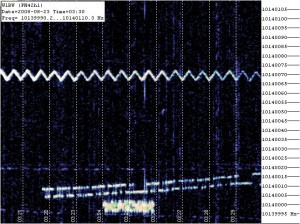
Addendum: Eric, WY7USA (nice call) copied my attempt at sending out a signal. I didn’t mention that I was trying to send out a slow version of SMT Feld Hell, because I didn’t have any luck with receiving it, but apparently Eric did. Witness his screen grab:
